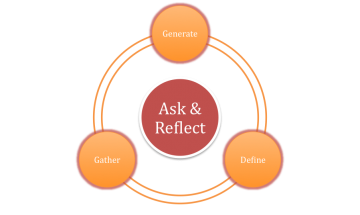Although there are various models illustrating the design and innovation process – ie. Moura’s ‘Ask, Try, Do’ model of design process, Schon’s Reflection-in-Action, or Beckman’s integration of the learning process and design – all of them one thing in common: design is not a one-step attempt. When I think about it, it almost seems silly to view innovation in isolation. People often associate innovation with something out of the ordinary that has never been done or thought of before. They are right; innovation by definition is a new method, idea, product and etc. But it has to exist within context. If there is no need for it or if it cannot be used or applied, it serves no value and is useless. Before jumping into the creation, one must consider what need or purpose the new product will serve. After the product has been created, it must be tested for usability. Therefore, an innovation or design is a process of different steps.
I personally see the design process as three different stages: Gather, Define and Generate, but it can turn into a five-step process, a seven-step process and so on depending on the task.
‘Gather’ is the collection of the relevant information needed to proceed with the design process. During the business canvas project, the Gather stage included the initial online research on the company and our meeting with Colin.
‘Define’ is setting direction and boundaries for the project to guide the process. It is the combination of Beckman’s Framework and Imperatives. Sometimes these are given and other times, you have to come up with what you think are appropriate.
‘Generate’ is the actual creation of the innovation. When we created a new business canvas for Raincity Strategies, we were in the Generate stage of the project.
This design process does not always go in the order of Gather, Define and Generate. If the scope of a project is given, you start with Define. If a new product does not work, you may have to go back to gather and obtain more information or redefine the boundaries. Flexibility is key.
Another thing to note about this design process is that Ask and Reflect are embedded in the process. It is the combination of Beckman’s idea of design process being interactive and Schon’s notion of back-talk. During the gathering stage, it is important to ask questions and obtain information from external sources to ensure completeness of the data. It is equally important to think about whether the acquired information is relevant and how it can be used. While defining the scopes of the project, ask about the limitations and restrictions and reflect on whether the scopes are too general or narrow. After the innovation has been created, run a test group and ask what works and what doesn’t. It is crucial to internally analyze the feedback and ask why something works or doesn’t. The Ask and Reflect is the juxtaposition of two opposing ideas – interaction among different parties involved and an internal reflection – that must happen at every stage of the design process.
I think mapping out a design process is difficult because there are many different ways of doing it. Beckman presents the Innovation Process and modifies it in various ways such as Problem and Solution Finding and Selecting or as Story-Telling. None of them are necessarily right or wrong. What works for someone may not necessarily work for others. This inability to exactly pinpoint the ‘right’ process, although can be frustrating, is valuable in my opinion. I think it is this flexibility in the process itself that allows for great innovations to materialize.
